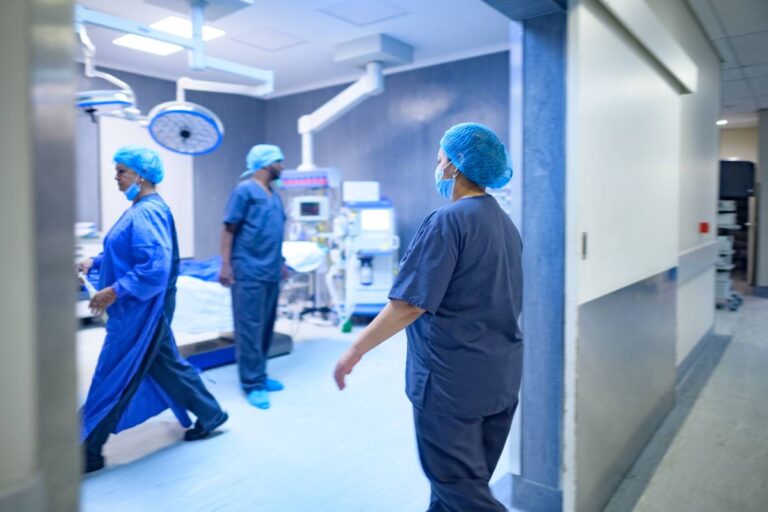Carbon dioxide (CO2) narcosis refers to the depressed level of consciousness resulting from the accumulation of carbon dioxide within the bloodstream.1 The symptoms of elevated CO2 in the body are due to deleterious effects on tissues and organs, including the brain, where narcosis occurs. CO2 narcosis can occur in a variety of situations. One notable circumstance is in the OR during the perioperative period.
The exact pathophysiology of hypercapnia (i.e., elevated levels of serum carbon dioxide) leading to depressed levels of consciousness has yet to be elucidated. However, current theories posit that the neurochemical changes arising from increases in serum carbon dioxide and pH result in an alteration of neurotransmitters—namely, GABA and glutamate—to promote a depressed level of consciousness.1
Risk factors that can lead to carbon dioxide narcosis include those which result in a decreased minute ventilation (i.e., total volume of air exchanged by an individual in one minute) as well as those which increase dead space within the lungs (i.e., the areas of the lungs that do not participate in gas exchange). In the latter case, the effectiveness of ventilation is decreased due to the inability for carbon dioxide and oxygen to be exchanged as dead space increases.
The perioperative risk of carbon dioxide narcosis secondary to hypoventilation (i.e., decreased respiration relative to what is needed to maintain baseline homeostasis, which includes consciousness) is increased by some neuromuscular diseases.2 Respiration involves the conscious effort of coordinated thoracic muscular contraction and relaxation to facilitate negative inspiratory force to draw oxygen into the lungs. Passive expiration, meanwhile, is largely devoid of active contraction.3 Some conditions associated with neuromuscular fatigue or dysfunction leading to hypoventilation include new kyphoscoliosis, muscular dystrophy which is characterized by progressive muscle fatigue, as well as amyotrophic lateral sclerosis.4 In addition, hypoventilation may be induced by pharmacologic agents used for anesthesia. In particular, opioids and their central respiratory depressant effects may induce hypoventilation, contributing to carbon dioxide narcosis.5 Therefore, it is imperative that timing and patient factors are considered when administering respiratory depressants such as opioids.
Conditions that result in increased dead space may result in hypercapnia, as the decreased effectiveness of gas exchange in the lungs can prevent CO2 from being exhaled properly. As a result, CO2 builds up in alveoli and eventually the blood stream.6 Common conditions associated with increased alveolar dead space include chronic obstructive pulmonary disease, asthma, obstructive sleep apnea, and pulmonary embolism.7 While risk factors for each of these associated conditions varies, patients who present with a diagnosis of either of these conditions should raise alarm for the increased risk for CO2 narcosis in the perioperative setting.
CO2 narcosis refers to the depressed level of consciousness that occurs due to the accumulation of carbon dioxide within the blood stream. Often, it is a ramification of either hypoventilation or impaired gas exchange—more specifically, the impaired exhalation of carbon dioxide. Patients with diagnoses associated with either of these predisposing factors should be monitored closely due to their increased perioperative risk of CO2 narcosis.
References
1. Drechsler M, Morris J. Carbon Dioxide Narcosis. In: StatPearls. StatPearls Publishing; 2025. Accessed October 20, 2025. http://www.ncbi.nlm.nih.gov/books/NBK551620/
2. Hallett Reid S, Toro F, Ashurst JV. Physiology, Tidal Volume. In: StatPearls. StatPearls Publishing; 2025. Accessed November 15, 2025. http://www.ncbi.nlm.nih.gov/books/NBK482502/
3. Brinkman JE, Toro F, Sharma S. Physiology, Respiratory Drive. In: StatPearls. StatPearls Publishing; 2025. Accessed November 15, 2025. http://www.ncbi.nlm.nih.gov/books/NBK482414/
4. Sivak ED, Shefner JM, Sexton J. Neuromuscular disease and hypoventilation. Curr Opin Pulm Med. 1999;5(6):355-362. doi:10.1097/00063198-199911000-00006
5. Palkovic B, Marchenko V, Zuperku EJ, Stuth EAE, Stucke AG. Multi-Level Regulation of Opioid-Induced Respiratory Depression. Physiol Bethesda Md. 2020;35(6):391-404. doi:10.1152/physiol.00015.2020
6. Pippalapalli J, Lumb AB. The respiratory system and acid–base disorders. BJA Educ. 2023;23(6):221-228. doi:10.1016/j.bjae.2023.03.002
7. Quinn M, St Lucia K, Rizzo A. Anatomy, Anatomic Dead Space. In: StatPearls. StatPearls Publishing; 2025. Accessed November 15, 2025. http://www.ncbi.nlm.nih.gov/books/NBK442016/

